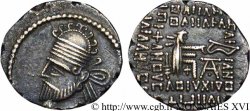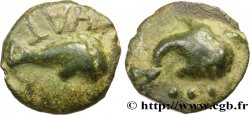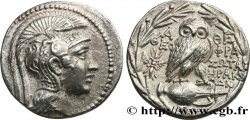- Accueil
- >
- >
v16_0111 - PARTHIEN - KÖNIGREICH DER PARTHER - PACORUS II Tétradrachme
MONNAIES 16 (2002)
Startpreis : 90.00 €
Schätzung : 180.00 €
unverkauftes Los
Startpreis : 90.00 €
Schätzung : 180.00 €
unverkauftes Los
Type : Tétradrachme
Datum: an 389
Name der Münzstätte / Stadt : Séleucie du Tigre
Metall : Scheidemünze
Durchmesser : 27,5 mm
Stempelstellung : 12 h.
Gewicht : 13,27 g.
Seltenheitsgrad : R1
Kommentare zum Erhaltungszustand:
Frappé sur un flan très large et pratiquement complet, mais très irrégulier ayant reçu plusieurs coups sur la tranche. Usure importante, mais parfaitement identifiable et lisible. Patine foncée
N° im Nachschlagewerk :
Pedigree :
Cet exemplaire provient de la collection Delorme
Vorderseite
Titulatur der Vorderseite ANÉPIGRAPHE.
Beschreibung Vorderseite Buste de Pacorus II à gauche, tête nue avec un bandeau quadruple, avec nœud qui tombe derrière la tête, la chevelure tombant sur la nuque, imberbe ; A derrière la tête.
Rückseite
Beschreibung Rückseite Vardanes Ier assis à gauche sur un trône à dossier tourné à droite, recevant une couronne de Tyché debout à gauche dans le champ à droite, drapée, tenant une corne d’abondance.
Legende des Reverses : BASILEWS/ BASILEWN/ ARSAKOU// EUERGETOU/ DIKAIOU// EPIFANOUS/ FILLENHNOS// QPT// DIOU
Übersetzung der Rückseite (Roi des rois Arsace, bienfaiteur, juste, glorieux, philhellène).
Kommentare
Cet exemplaire est illustré dans l’article de P. Delorme (N&C 321, p. 38, fig. 31). Poids léger. Notre exemplaire est daté d’octobre 77 après J.-C (an 389 de l’ère arsacide), le mois est lisible à l’exergue, (Dios) pour octobre, date qui doit correspondre au début de la révolte de Pacorus II contre l’autorité de Vologèse Ier. L’ère parthe commençait en 312 avant J.-C., reposant sur l’ère séleucide et la dédicace de Séleucie du Tigre par son fondateur, Séleucus Nicator. Le début de l’année parthe était fixée au mois d’octobre (Dios) et l’année basée sur un calendrier lunaire avec un mois intercalaire.
This example is illustrated in the article by P. Delorme (N&C 321, p. 38, fig. 31). Light weight. Our example is dated October 77 AD (year 389 of the Arsacid era), the month is legible in the exergue, (Dios) for October, a date which must correspond to the beginning of the revolt of Pacorus II against the authority of Vologeses I. The Parthian era began in 312 BC, based on the Seleucid era and the dedication of Seleucia on the Tigris by its founder, Seleucus Nicator. The beginning of the Parthian year was fixed in the month of October (Dios) and the year based on a lunar calendar with an intercalary month
This example is illustrated in the article by P. Delorme (N&C 321, p. 38, fig. 31). Light weight. Our example is dated October 77 AD (year 389 of the Arsacid era), the month is legible in the exergue, (Dios) for October, a date which must correspond to the beginning of the revolt of Pacorus II against the authority of Vologeses I. The Parthian era began in 312 BC, based on the Seleucid era and the dedication of Seleucia on the Tigris by its founder, Seleucus Nicator. The beginning of the Parthian year was fixed in the month of October (Dios) and the year based on a lunar calendar with an intercalary month








 Berichten über einen Fehler
Berichten über einen Fehler Die Seite drucken
Die Seite drucken Teilen meiner Auswahl
Teilen meiner Auswahl Stellen Sie eine Frage
Stellen Sie eine Frage Einlieferung/Verkauf
Einlieferung/Verkauf
 Details
Details














